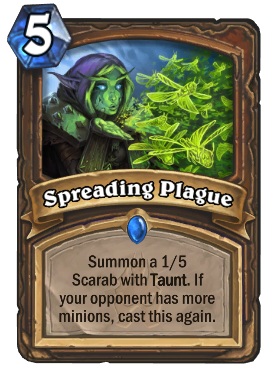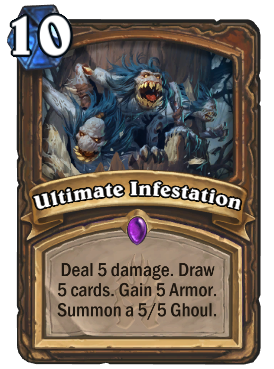What should be done to fix Hearthstone's Druid problem
Will no one rid me of these meddlesome mana crystals?

If you've played, watched or read any amount of Hearthstone since the release of Knights of the Frozen Throne, then you will have noticed a troubling, green menace, threatening to consume the game. On August 24th, Jeff Clark, co-host of the Coin Concede podcast and member of the Gosu Crew, noted the following about his recent Ladder experience:
For anyone interested, out of 86 games in rank 5+, 41% of them were against Druid :/August 24, 2017
After digesting an ungodly amount of all things Hearthstone over the past couple weeks in the wake of KFT's release, I've seen the same sentiment echoed many times.
Druid has always been one of Hearthstone's more popular classes, but the current mania for Malfurion in all forms is something else entirely. Why is Druid so pervasive and oppressive now? The answer is fairly simple: Spreading Plague and Ultimate Infestation.
The Problem Children
I'm of the mind that Druid should be one of two things. The class can either have the potentially infinite value of the Jade package or the board-controlling, card-advantage-producing Spreading Plague/Ultimate Infestation package. But it shouldn't have access to both, at least not in their current forms, for reasons we’re about to explore.

Spreading Plague helps Druid deal with one of its biggest weaknesses: decks that develop a wide board of many small minions.
Jade Druid was a fantastic deck before Knights of the Frozen Throne, but it was not without weaknesses. The deck was arguably Tier 1, and that was fine; Tier 1 decks will always exist. Amassing Jade Golems and ramping mana were powerful strategies, but they cost you resources that weren't easily replenished. Even so, the inevitability that Jade Idols provided in the late game, with their ability to both avoid fatigue and produce a string of exceedingly cheap larger and larger minions, created a strategy that menaced most control decks.
Historically, Druid has always had a problem with two things: dealing with decks that went wide and running out of steam after casting all of their ramp spells. So why did Blizzard choose to solve both of these shortcomings in a single expansion?
Compared to cards like Swipe and Starfall, the latter of which is hardly played these days, Spreading Plague is an entirely different beast. I've been on both sides of the board when it was filled with 1/5 Scarabs, and lemme tell ya, it can be pretty miserable. Anything over two Scarabs is quite difficult to deal with, and compared to the other five-mana token-maker in KFT, Webweave almost seems laughable.
Comic deals, prizes and latest news
Sign up to get the best content of the week, and great gaming deals, as picked by the editors.
The other major offender? You knew as soon as you clicked on this article that we would be talking about Ultimate Infestation. The biggest question we're asking right now is whether this card is broken on its own, or just in conjunction with all the ramp that's present in Standard. In fact, Kibler omitted Ultimate Infestation from his list of KFT cards he expected to have the most impact in Standard.

If Hearthstone had Legendary spells, Ultimate Infestation could easily be one of them.
"What I underestimated was the sheer amount of mana ramp that exists in the Standard format," Kibler admitted, "and the return on investment, essentially, you get by putting pretty much all of it in your deck."
While ten mana is the pinnacle of costs in Hearthstone, thanks to all the ramp Druid has available to it, it's possible to play Ultimate Infestation as early as turn four or five. As you can imagine, this can be pretty game breaking, especially when you're beginning your fifth or sixth turn with a 5/5, a full hand, and nine or ten mana.
Coming from a different card game (Magic: The Gathering), I can tell you that there are certain times cards and abilities are deliberately 'pushed,'—that is, designed more powerfully than they normally would be in the hopes that they stand out or 'wow' people. These typically end up being the marquee cards in a set and often times this works out poorly, with the cards in question receiving a ban (or a nerf in a digital card game). While I have no evidence that this is the case with Ultimate Infestation, it certainly feels that way. If Hearthstone had Legendary spells, it could easily be one of them.
While Malfurion the Pestilent is undoubtedly a powerful Death Knight, I don't think he would single-handedly put Druid over the top without the other two culprits, so honestly, I'm less concerned by his impact. He's definitely not the strongest Death Knight, but he’s one of the most versatile, consistent, and probably has the best shell to work with currently.
But what if the problem doesn't actually lie with any of the new KFT cards? If we're looking outside the latest set, a few notable pros, such as TempoStorm's Reynad, have made the claim that Innervate is one of the main problematic cards.
"Basically there's no way that the metagame solves the Druid problem in a healthy way...I think Innervate needs to go Hall of Fame," Reynad claims. "I don't think Blizzard should wait six months to see it pan out. I don't think they should wait eight months to see it pan out...that card needs to leave right now."
This is an interesting argument and one that should be taken seriously. You see, Basic cards may seem innocuous, but just like the Wild format itself, the more cards that are printed, the greater the chance these older cards have to be abused with new and unique interactions. Every time a new card is printed, you have to look at how it interacts with cards such as Innervate or Starving Buzzard. Unfortunately, you don't really need to build a deck around Innervate to take advantage of its power level; you simply need to have cards in one.
This doesn't even touch upon the other automatic two-of in every Druid deck, Wild Growth, which is also disgustingly powerful. These cards allow Druid decks to often play numerous steps ahead of their opponent, while refuelling at the end with a card like Ultimate Infestation. At least with a card like Nourish you were essentially spending your entire turn just drawing cards, which resulted in a relevant loss of tempo.
The Solution
Are these balance issues? Most certainly. The beauty of digital card games is that you're able to change cards on the fly if they seem to be a little off, so everything can ultimately be a balance issue. I got to speak with some of the game designers a couple months back, and we got to talking about the The Caverns Below problem at the time. They asked what I would do, and I remember suggesting that maybe the card require five minions with the same name or that all your minions become 4/4's; simple number tweaks such as this could change the entire identity of a card. And they did. The Caverns Below is basically nonexistent on Ladder now after its nerf.
What kind of changes could we make to Spreading Plague or Ultimate Infestation that would yield similar (if not better) results?
You could take Ultimate Infestation down to four armor, four cards, four damage, and a 4/4 and it would still be playable, maybe even still overpowered.
See, it's awkward to change the Scarab tokens to anything other than 1/5s because Scarab tokens have already been defined by other cards as 1/5s, specifically on Malfurion the Pestilent and implicitly on Druid of the Swarm. Alternatives might be changing the casting cost to six, or perhaps limiting the number of times the ability is recast to something like three.
Ultimate Infestation has a little more wiggle room in terms of solutions. I think you want to retain the elegance of symmetry on the card, so you could easily change everything to four and still have an extremely playable card. Four armor, four cards, four damage, and a 4/4 is still completely reasonable; I assume most decks would still play two copies. It might even still be too powerful, but that remains to be seen.
The one thing we always have to ask ourselves in moments like this, when we're utterly begging for a change, is have we given the meta enough time to adjust? This is the age old question that there is literally no correct answer to. It's a damned if you do, damned if you don't situation for Blizzard, and I don't envy their position. If they adjust things now, it leaves players scrambling to find the next best deck for whatever upcoming events they might be competing in. If they wait, they run the risk of players losing interest in the current meta and the attendance at said events suffering; in the weeks following a brand new set's release, this is basically the last thing you want to happen. It's a difficult decision, make no mistake.
Would nerfs like these even be enough though? Would they render exciting, new cards unplayable? It's hard to say, but I look forward to seeing what Blizzard comes up with—hopefully sooner rather than later.
Most Popular



